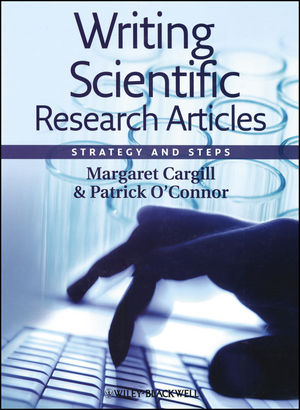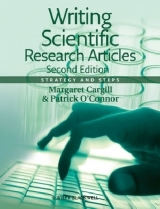
Writing Scientific Research Articles
Wiley-Blackwell (an imprint of John Wiley & Sons Ltd) (Verlag)
978-1-4051-9335-1 (ISBN)
- Titel ist leider vergriffen;
keine Neuauflage - Artikel merken
The book is designed for scientists who use English as a first or an additional language; for research students and those who teach them paper writing skills; and for early-career researchers wanting to hone their skills as authors and mentors. It provides clear processes for selecting target journals and writing each section of a manuscript, starting with the results. The stepwise learning process uses practical exercises to develop writing and data presentation skills through analysis of well-written example papers. Strategies are presented for responding to referee comments, as well as ideas for developing discipline-specific English language skills for manuscript writing. The book is designed for use by individuals or in a class setting. Visit the companion site at www.writeresearch.com.au for more information.
Margaret Cargill is an applied linguist with over 15 years experience as a research communication educator. Her current research centres on innovative collaborative methods for helping scientists develop high-level skills for communicating their research findings effectively in the international arena. She has worked extensively in Australia, Europe and Asia with scientists of many language and cultural backgrounds. Patrick O'Connor is a research ecologist, environmental consultant and science educator. His work over the last 10 years has focussed on the use of scientific principles in designing and evaluating environmental programs for governments and statutory authorities in Australia. His research interests and scientific publications span fields of terrestrial ecology and detection of change in plant and animal communities.
Preface. Part 1: A Framework for success . 1 How the book is organised, and why. 1.1 Getting started with writing for international publication. 1.2 Publishing in the international literature. 1.3 Aims of this book. 1.4 How the book is structured. 2 Research article structures. 2.1 Conventional article structure: AIMRaD and its variations. 3 Referees' criteria for evaluating manuscripts. Part 2: When and how to write each article section . 4 Results as 'story': the key driver of an article. 5 Results: turning data into knowledge. 5.1 Figure, table or text?. 5.2 Designing figures. 5.3 Designing tables. 5.4 Figure legends and table titles. 6 Writing about Results. 6.1 Functions of Results sentences. 6.2 Verb tense in Results sections. 7 Methods sections. 7.1 Purpose of the Methods section. 7.2 Organising Methods sections. 7.3 Use of passive and active verbs. 8 Introductions. 8.1 Five 'stages' to a compelling Introduction. 8.2 Stage 1: Locating your project within an existing field of scientific research. 8.3 Using references in Stages 2 and 3. 8.4 Avoiding plagiarism when using others' work. 8.5 Indicating the 'gap' or 'research niche'. 8.6 Stage 4: The statement of purpose or main activity. 8.7 Suggested process for drafting an Introduction. 8.8 Editing for logical flow. 9 Discussion sections. 9.1 Information elements to highlight the key messages. 9.2 Negotiating the strength of claims. 10 Titles. 11 Abstracts. Part 3: Getting your manuscript published . 12 Evaluating journals. 12.1 Considerations when selecting a target journal. 13 Submitting a manuscript. 14 How to respond to editors and referees. 14.1 Rules of thumb for responding to editors and referees. 14.2 How to deal with manuscript rejection. 14.3 How to deal with 'conditional acceptance' or 'revise and resubmit'. 15 A Process for preparing a manuscript. 15.1 Initial preparation steps. 15.2 Editing procedures. 15.3 A pre-review checklist. Part 4: Further developing your publication skills. 16 Skill development strategies for groups and individuals. 16.1 Journal clubs. 16.2 Writing groups. 16.3 Matching feedback strategies to different purposes. 16.4 Training for responding to reviewers. 17 Developing discipline-specific English skills. 17.1 Introduction. 17.2 What kind of English errors matter most?. 17.3 Strategic (and acceptable!) language re-use: Sentence templates. 17.4 More about Noun Phrases. 17.5 Concordancing: a tool for developing your discipline specific English. 17.6 Using the English articles (a/an, the) appropriately in science writing. 17.7 Using 'which' and 'that'. 18 Answer pages. 19 References. Part 5: Provided example articles. 20 Kaiser, B.N., Moreau, S., Castelli, J., Thomson, R., Lambert, A., Bogliolo, S., Puppo, A., & Day, D.A. (2003) The soybean NRAMP homologue, GmDMT1, is a symbiotic divalent metal transporter capable of ferrous iron transport. The Plant Journal, 35, 295-304. 21 Britton-Simmons, K.H. & Abbott, K.C. (2008) Short- and long-term effects of disturbance and propagule pressure on a biological invasion. Journal of Ecology, 96, 68-77.
| Zusatzinfo | Illustrations |
|---|---|
| Verlagsort | Chicester |
| Sprache | englisch |
| Maße | 209 x 278 mm |
| Gewicht | 686 g |
| Einbandart | gebunden |
| Themenwelt | Geisteswissenschaften ► Sprach- / Literaturwissenschaft ► Literaturwissenschaft |
| Naturwissenschaften ► Biologie ► Ökologie / Naturschutz | |
| Schlagworte | Wissenschaftlicher Text |
| ISBN-10 | 1-4051-9335-2 / 1405193352 |
| ISBN-13 | 978-1-4051-9335-1 / 9781405193351 |
| Zustand | Neuware |
| Haben Sie eine Frage zum Produkt? |
aus dem Bereich



